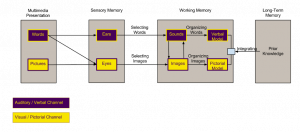59 Multimedia Learning Theory
Multimedia Learning Theory
Mayer and Moreno’s (1999) Cognitive Theory of Multimedia Learning states that deeper learning can occur when information is presented in both text and graphics than by text alone. The theory of Multimedia Learning hinges on the presumptions that there are two channels for learning: auditory and visual. These channels are both used to process information into working memory.

The Multimedia Theory of Learning can be broken down into a series of seven principles as defined by Clark and Mayer (2003):
- Multimedia Principle: Words and Graphics are Better Than Words Alone
- Contiguity Principle: Align Words to Corresponding Graphics
- Modality Principle: Present Words as Audio Narration, Rather Than On-Screen Text
- Redundancy Principle: Explain Visuals with Words in Audio or Text, Not Both
- Coherence Principle: Adding Interesting Material Can Hurt Learning
- Personalization Principle: Use Conversational Style and Virtual Coaches
- Segmenting and Pretraining Principle: Managing Complexity by Breaking a Lesson into Parts
This theory is predicated on the theories of cognitive load and information processing. Cognitive load occurs when extraneous information completes the processing capabilities of the working memory and therefore interferes with the learning process. Information processing theory states that information we learn passes through stages in our memory via a series of processes that allow it to be retained in long-term memory. Multimedia learning theory is based on the idea that when using multimedia, it is important to reduce cognitive load and therefore improve the information processing capabilities of our memory. Mayer and Moreno (2003) state: “A major challenge for instructional designers is that meaningful learning can require a heavy amount of essential cognitive processing, but the cognitive resources of the learner’s information processing system are severely limited. Therefore, multimedia instruction should be designed in ways that minimize any unnecessary cognitive load” (p. 50).
Implications for the classroom
- In the presentation of information, use both words and graphics to provide instruction or content
- Keep text and graphics aligned
- Use narration whenever possible, but do not use narration and on-screen text at the same time
- Avoid using images, audio, transitions, and other elements that distract or that do not relate to the content
- Use a conversational style and consider using avatars or virtual learning coaches to guide learning
- Break lessons into small “chunks” of 10-15 minutes maximum
Teaching Strategies that support this learning theory
On the Web
- Cognitive Theory of Multimedia Learning
- Mayer’s Theory of Multimedia Learning Unpacked and Illustrated
- Designing for Mobile Learning: Clark and Mayer’s Principles Applied
In the library/ References
Alessi, S., & Trollip, S. (2001). Multimedia for Learning: Methods and Development (3rd ed.). Needham Heights: Pearson.
Clark, Ruth. C., Mayer, Richard. E. (2003). E-Learning and the science of instruction: proven guidelines for consumers and designers of multimedia learning. Jossey-Bass/Pfeiffer Edition. ISBN: 0-7879-6051-0
Mayer, R. E. (2014). Incorporating motivation into multimedia learning. Learning and Instruction, 29, 171.
Moreno, R., & Mayer, R. E. (1999). Cognitive principles of multimedia learning: The role of modality and contiguity. Journal of Educational Psychology, 91(2), 358-368. doi:10.1037/0022-0663.91.2.358
Mayer, R. E., & Moreno, R. (2003). Nine ways to reduce cognitive load in multimedia learning. Educational Psychologist, 38(1), 43-52. doi:10.1207/S15326985EP3801_6

